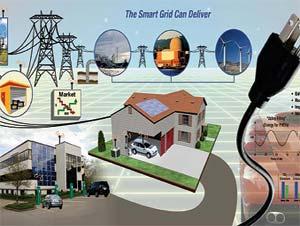Smart grid powers energy efficiency
Smart grid diagram. (Image: US Department of Energy)
President Obama has been criss-crossing the country, talking up clean energy at the country’s largest solar power plant in Arcadia, Florida. The President delivered $3.4 billion dollars worth of grants to update electricity transmission, and create what’s called a smart grid to increase efficiency and promote energy-saving choices for consumers.
“We can imagine the day when you’ll be able to charge the battery on your plug-in hybrid car at night, because your smart meter reminded you that nighttime electricity is cheapest,” said the President. “In the daytime, when the sun is at its strongest, solar panels like these and electricity stored in car batteries will be able to power the grid with affordable, emission-free energy.”
Boulder, Colorado has already partnered with the utility company Xcel Energy to pioneer the smart grid in homes. Kara Mertz works for the city of Boulder as manager of the project.
She explains what a home on the smart grid look likes: “It looks like a normal home, but what you see is you see programmable thermostats on the walls, and those programmable thermostats are controlled through a website. So, the homeowner in that house can go online, and they can say, during the hours of two PM to eight PM please turn my thermostat down four degrees, since that is when the power is most expensive.
“So, you could program the temperature of your home, when your appliances come on and off in that home. So, for example, if you know you work during the day and you don’t need your plasma TV on standby all day long, but you want it to turn on at like four o’clock so when you come home at five, you just flip it on and it’s already warmed up. Then you can program that through this website, as well.”
The thermostats and appliances all have manual overrides, says Mertz.
“And there’s some programs that Xcel is going to be piloting here, where you can program this to say I don’t want my electricity bill to be more than $100 a month, so warn me, you know, when I’m at the 75 percent point, and I can adjust my usage so that I know I can depend on a $100 per month electricity bill.”
Mertz says Xcel, in managing the smart grid, is able to efficiently match supply with demand. “The other part of it is to minimize their operational costs by sensing outages before they happen. They have sensors on the transformers that record temperature, so if a transformer is getting hot, the control center can see that and route the power around that transformer before it blows.
“Whereas, right now, the way that they sense outages is they sit around essentially waiting for someone to call, and a customer calls up and says my electricity is out, and they say ‘thank you very much’ and they make note in their outage system of your address. And then they sit around and wait for someone else to call. Once, you know, ten or 15 people have called … then they can say, hmm, it looks like maybe it’s this transformer over here that’s out because we see the pattern of who’s calling us, we’d better send a truck out. And that’s like a 20-minute or hour-long process.”
And, according to Mertz, if you have an electric car, that could be an extra bonus for your electricity bill.
“The idea is that if there’s a high enough concentration of electric cars or hybrid electric vehicles that are plugged into the grid, then Xcel can draw power that’s stored in the batteries of those cars in times of peak energy demand. The vision is that each car would have an individual IP address, much like your computer does, and so it wouldn’t matter where you were plugged in, Xcel would recognize your vehicle and credit your electricity bill.”
The energy future that Mertz sees is one where power is individualized. “I’m hopeful about the promise of putting power back into the hands of the consumer because, really, electricity is so ethereal to most people, it’s invisible. You kind of don’t know how much it costs on a day-to-day basis or an hour-by-hour basis, and you don’t really know if it’s coal you’re causing to be burned or solar power that you’re drawing from. And, so I think this would allow us all to know our power as individuals and know where it’s coming from.”
Hosted by Steve Curwood, “Living on Earth” is an award-winning environmental news program that delves into the leading issues affecting the world we inhabit. More “Living on Earth.”
